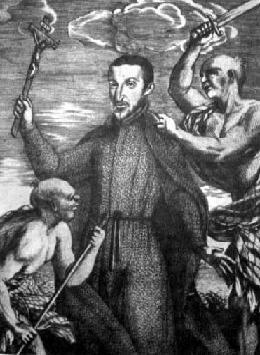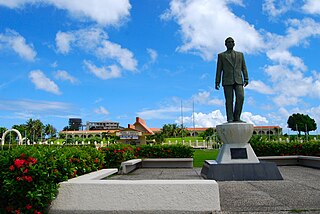
Guam is an organized, unincorporated territory of the United States in the Micronesia subregion of the western Pacific Ocean. It is the westernmost point and territory of the United States ; its capital Hagåtña (144°45'00"E) lies further west than Melbourne, Australia (144°57'47"E). In Oceania, Guam is the largest and southernmost of the Mariana Islands and the largest island in Micronesia. Guam's capital is Hagåtña, and the most populous village is Dededo.
The history of Guam starts with the early arrival around 2000 BC of Austronesian people known today as the Chamorro Peoples. The CHamorus then developed a "pre-contact" society, that was colonized by the Spanish in the 17th century. The present American rule of the island began with the 1898 Spanish–American War. Guam's history of colonialism is the longest among the Pacific islands.

The demographics of Guam details an array of demographic statistics relating to the territory of Guam. This includes statistics on population, including the Indigenous population; religious affiliations; language; and immigration. Furthermore, The Demographics of Guam provides an overview of the history of Guam, as well as a depiction of the villages in the United States territory and its populace. The population of Guam, as of July 2021 was 168,801, based on data procured from the CIA World Factbook. While there are no large cities in Guam, however the populace resides in villages. The most populated village in Guam is Dededo, with a population of 44,943 in 2010. The Indigenous people of Guam are known as the Chamorro people, and are the largest ethnic group in Guam, however this group is categorised as a minority in the United States territory. The mean age in the territory of Guam is 31.4 years. Guam is in the Mariana Islands, and is the largest and most populated of the territories in this location.
Stand Ye Guamanians, officially known as the Guam Hymn, is the regional anthem of Guam. The original English lyrics and music were written and composed in 1919 by Ramon Manilisay Sablan. The lyrics were slightly modified by the U.S. government prior to official adoption in 1952. In 1974, Lagrimas Leon Guerrero Untalan translated the English lyrics into CHamoru, which were made official in 1989. The CHamoru version is more widely used today.

Hagåtña is the capital village of the United States territory of Guam. From the 18th through mid-20th century, it was Guam's population center, but today it is the second smallest of the island's 19 villages in both area and population. However, it remains one of the island's major commercial districts in addition to being the seat of government.

Chamorro is an Austronesian language spoken by about 58,000 people. It is the native and spoken language of the Chamorro people, the indigenous people of the Marianas. There are three different dialects of Chamorro — Guamanian, Rotanese, and the general NMI dialects.

The Chamorro people are the indigenous people of the Mariana Islands, politically divided between the United States territory of Guam and the encompassing Commonwealth of the Northern Mariana Islands in Micronesia. Today, significant Chamorro populations also exist in several U.S. states, including Hawaii, California, Washington, Texas, Tennessee, Oregon, and Nevada, all of which together are designated as Pacific Islander Americans according to the U.S. Census. According to the 2000 Census, about 64,590 people of Chamorro ancestry live in Guam and another 19,000 live in the Northern Marianas. Another 93,000 live outside the Marianas in Hawaii and the West Coast of the United States.

Matå'pang was a Chamorro maga'låhi or chief of the ancient Chamorro village of Tomhom on the island of Guahan. His name meant "to be made pure by cleansing" in Chamorro.

Naval Air Station Agana is a former United States Naval air station located on the island of Guam. It was opened by the Japanese Navy in 1943 and closed by the United States government in 1995. During and after its closure, it was operated alongside Antonio B. Won Pat International Airport.

Guam The following outline is provided as an overview of and topical guide to Guam:
Angel Anthony Leon Guerrero Santos III, also known as Angel L.G. Santos, or Anghet, was a Chamorro rights activist and Guamanian politician. Santos served as a Senator in the Guam Legislature from 1995 to 1999 and again from 2001 to 2003, and was a candidate for Governor of Guam in 1998 with his running mate Jose “Pedo” Toves Terjale, a future Mayor of Yona.

Yigo, Guam is the northernmost village of the United States territory of Guam, and is the location of Andersen Air Force Base. The municipality of Yigo is the largest village on the island in terms of area. It contains a number of populated places, including Asatdas and Agafo Gumas.

The culture of Guam reflects traditional Chamorro customs in a combination of indigenous pre-Hispanic forms, as well as American, Spanish and Mexican traditions. Post-European-contact CHamoru Guamanian culture is a combination of American, Spanish, Filipino, other Micronesian Islander and Mexican traditions. Few indigenous pre-Hispanic customs remained following Spanish contact, but include plaiting and pottery, and there has been a resurgence of interest among the CHamoru to preserve the language and culture. Hispanic influences are manifested in the local language, music, dance, sea navigation, cuisine, fishing, games, songs and fashion.

Adelup Point is limestone promontory in Hagåtña, Guam that extends into the Philippine Sea and separates Asan Bay from Hagåtña Bay. It has been the site of the Ricardo J. Bordallo Governor's Complex since 1990. Adelup is therefore a metonym for the Office of the Governor of Guam.

Latte Stone Park, officially Senator Angel Leon Guerrero Santos Latte Stone Memorial Park, is an urban park in Hagåtña, Guam. Established in the 1950s and operated by the Guam Department of Parks and Recreation, it is best known for its set of eight historical latte stones, which were transferred from their original site in Fena. The Park is located along the cliffline below the Governor's residence in Agana Heights and south of the Plaza de España. It is often visited by sightseers visiting central Hagåtña. The park also includes the entrances to two sets of caves that were constructed during the Japanese occupation (1941–1944) by forced laborers and that were listed in the National Register of Historic Places in 1991 as the Agana/Hagåtña Cliffline Fortifications.
Laura Maud Thompson was an American social anthropologist best known for her studies of CHamoru culture in Guam. She studied many cultures around the world, including many Native American nations, with the self-professed aim of "trying to build an integrated theory of human group behavior that was grounded in actual behavior and relied on rigorous methods of verification to ensure reliability." She was the recipient of the 1979 Bronislaw Malinowski Award from the Society for Applied Anthropology.
Agualin, sometimes Aguarin or Diego de Aguarin, was a CHamoru chief who led a siege of Hagåtña (1676–1677) on Guam during the Spanish-Chamorro Wars. This was the second of three unsuccessful sieges of the Spanish presidio carried out by CHamorus seeking to eject the colonial presence, with the final widespread violence on Guam in 1683. While Spanish colonial history vilified Agualin as being anti-Christian and anti-civilization, a modern reevaluation reframes Agualin as a champion of CHamoru nationalism.

Pago Bay is the largest bay on the U.S. territory of Guam, located at the mouth of Pago River on the island's eastern coast. There is extensive evidence of CHamoru settlement before Spanish colonization during the late seventeenth century. During the Spanish-Chamorro Wars, the Spanish transferred the populations of Tinian and Aguigan to the village of Pago. However, a smallpox epidemic in 1856 killed much of the village's population and the Spanish moved survivors to other villages, leaving the bay shoreline largely uninhabited. The bay is popular with fishermen and recreationalists, and was the site of new housing development in the 2000s.
Hope Alvarez Cristobal is a Guamanian educator, activist, politician, farmer, and museum director. Cristobal is a former Democratic senator in the Guam Legislature. Cristobal is known for advocating for indigenous rights of the Chamorro people.
Michael Lujan Bevacqua is a Chamorro scholar, activist, author, producer and editor. He currently lives in Mangilao, Guam and works at the Guam Museum as a curator. Bevacqua founded the first ever Chamorro Studies Program at the University of Guam in 2011, where he worked as a professor teaching the history of Guam and the Chamorro language for 10 years.












